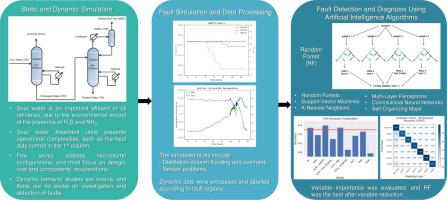Process Safety and Environmental Protection ( IF 6.9 ) Pub Date : 2022-07-25 , DOI: 10.1016/j.psep.2022.07.043 Júlia do Nascimento Pereira Nogueira , Príamo Albuquerque Melo , Maurício B. de Souza Jr.

|
Fault Detection and Diagnosis (FDD) is a Process System Engineering (PSE) area of great importance, especially with increased process automation. It is one of the chemical engineering fields considered promising to Artificial Intelligence (AI) application. FDD systems can be useful to supervise Sour Water Treatment Units (SWTU) behavior, as they are chemical processes that present operational difficulties when disturbances occur. SWTU remove contaminants from sour water (SW) streams generated through petroleum processing, consisting mainly of small amounts of H2S and NH3. They are considered one of the primary aqueous wastes of refineries and cannot be disposed of due to environmental regulations. However, no previous studies focused on the development of FDD systems for SWTU exist and works on its dynamics are scarce. Hence, the present work proposes to study the dynamic simulated behavior of an SWTU and develop an FDD system applying AI techniques with hyperparameters optimization. The simulation was performed in Aspen Plus Dynamics® and ran to create normal operation and six relevant faults, including occurrences in the process (e.g., inundation and fouling) and sensors. FDD was performed through data classification, and results were evaluated mainly by accuracy and confusion matrices. Even after variable reduction, FDD was satisfactory with over 87.50% accuracy in all AI techniques. RF and SVM with linear and Gaussian kernels presented the best results, with over 93% of accuracy in training and testing, and had the shortest computing times. The second column’s sump level proved to be the most relevant variable for fault identification.
中文翻译:

酸性水处理装置故障场景:仿真和基于人工智能的诊断
故障检测和诊断 (FDD) 是一个非常重要的过程系统工程 (PSE) 领域,尤其是随着过程自动化程度的提高。它是被认为具有人工智能(AI)应用前景的化学工程领域之一。FDD 系统可用于监督酸性水处理装置 (SWTU) 的行为,因为它们是在发生干扰时会出现操作困难的化学过程。SWTU 去除石油加工产生的酸性水 (SW) 流中的污染物,主要由少量H 2 S和NH 3组成. 它们被认为是炼油厂的主要水性废物之一,并且由于环境法规而无法处理。然而,以前没有针对 SWTU 开发 FDD 系统的研究,并且关于其动态的工作也很少。因此,目前的工作建议研究 SWTU 的动态模拟行为并开发应用 AI 技术的 FDD 系统通过超参数优化。模拟在 Aspen Plus Dynamics® 中执行并运行以创建正常操作和六个相关故障,包括过程中发生的故障(例如,淹没和结垢)和传感器。FDD通过数据分类进行,结果主要通过准确度和混淆矩阵进行评估。即使在变量减少之后,FDD 在所有 AI 技术中的准确率都令人满意,准确率超过 87.50%。具有线性和高斯核的RF 和SVM表现出最好的结果,在训练和测试中的准确率超过 93%,并且计算时间最短。第二列的油底壳水位被证明是与故障识别最相关的变量。











































 京公网安备 11010802027423号
京公网安备 11010802027423号